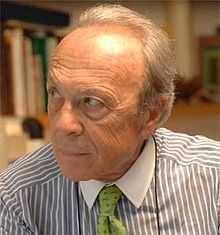Manfredi Nicoletti

Manfredi Nicoletti (born 16 June 1930) is an Italian architect.
Biography
Born in Rieti, Nicoletti began his artistic and intellectual career very young in the studio of Giacomo Balla. In Rome he studied under Pier Luigi Nervi and graduated in architecture in 1954. In the same year he got a Fulbright Scholarship to the Massachusetts Institute of Technology where he took his masters degree in 1955. During that time he was a student of Buckminster Fuller, Pietro Belluschi, Eero Saarinen, and Louis Kahn. He worked in the studio of Walter Gropius and was assistant to Sigfried Giedion at Harvard University. Up to 1957 he collaborated with the studio of Minoru Yamasaki.
On his return to Italy, he worked with Pier Luigi Nervi. As a member of the National Institute for Urban Studies he was one of the founders of the National Institute for Architecture. In 1962 he returned to MIT with a Sloan Grant and was a member of the Joint Center for Urban Studies. During the years 1963-1964 he travelled through Europe, the Middle East and Asia preparing studies of cave architecture which were later published in the essay of 1980 which won him the Comité International des Critiques d’Architecture prize. In 1963 he was a teacher of architecture at the Rhode Island School of Design. In 1965 he founded with Paul Maymont, Yona Friedman and Michel Ragon the Groupe International d’Architecture Prospective (GIAP). He is a pioneer of Megastructural architecture.[1] He taught in Aquila and Rome; he was full professor of architectural composition in Palermo from 1980 and in Rome from 1988.
Founding Partner, together with Luca Nicoletti and Giulia Falconi, of Studio Nicoletti Associati, at present he is Emeritus professor of Architectural Composition at the Rome La Sapienza University, Vice President of the International Academy of Architecture, Member of the Academy of Architecture of Russia, Member of the International Academy of Architecture of Moscow and member of the Academy of Architecture of France. Honorary Fellow of the American Institute of Architects and of the Royal Architectural Institute of Canada. From the Minister of Culture of France he received the title of “Commandeur de l’Ordre des Arts et des Lettres”. Twice awarded with the Dedalo Minosse Prize. His professional experience embraces many aspects of urban and architectural design, especially of public buildings, carried out in Europe, the United States, Africa, the Middle and Far East, where they were integrated with those of specialists in various scientific and technological sectors.
Main projects
- Social Housing, Rieti (1965)
- Artificial Peninsula in Fontvieille, Principauté de Monaco (1968)
- Helicoidal Skyscraper, New York (1968)
- Airport of Reggio Calabria (1974)
- Seafront of Reggio Calabria (1976)
- Social Housing, Gela (1976)
- Urban Plan, Gela (1978)
- Airports of Trapani, Lampedusa and Pantelleria (1978)
- Airport and Control Tower, Catania (1978)
- Moncada House, Bagheria (1987)
- University Campus, Udine (1990)
- General Hospital, Agrigento (1991)
- Urban Plan, Rieti (1992)
- Scientific Greenhouse, University of Catania (2000)
- Zoological Museum, Catania (2000)
- Sport Palace, Palermo (2001)
- Italian Parliament Conference Centre, Roma (2002)
- Police Headquarters, Rieti (2002)
- Millennium Park, Abuja Nigeria (2003)
- New Courthouse, Lecce (2004)
- Unità d’Italia Square, Rieti (2004)
- New Courthouse of Arezzo, Arezzo (2008)[2]
- Kazakhstan Central Concert Hall, Astana Kazakhstan (2009)
- Millennium Tower, Abuja Nigeria U.C. (expected 2014)
- Petaling Jaya "The Pod" Pavilion, Kuala Lumpur Malaysia (2010)